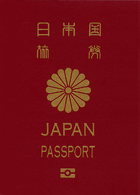- Imperial Seal of Japan
-
Imperial Seal of Japan 
Details Armiger Akihito Emperor of Japan Crest Chrysanthemum Orders Order of the Chrysanthemum The Imperial Seal of Japan is a mon or crest used by members of the Japanese Imperial family. Under the Meiji Constitution, no one was permitted to use the Imperial Seal except the Emperor of Japan, who used a 16 petal chrysanthemum with sixteen tips of another row of petals showing behind the first row. Therefore, each member of the Imperial family used a slightly modified version of the seal. Shinto shrines either displayed the imperial seal or incorporated elements of the seal into their own emblems.
Earlier in Japanese history, when Emperor Go-Daigo, who tried to break the power of the shogunate 1333, was exiled, he adopted the seventeen petal chrysanthemum to differentiate himself from his successor, Emperor Kōgon, who kept the imperial 16 petal mon.
The symbol is a yellow or orange chrysanthemum with black or red outlines and background. A central disc is surrounded by a front set of 16 petals. A rear set of 16 petals are half staggered in relation to the front set and are visible at the edges of the flower. An example of the chrysanthemum being used is in the badge for the Order of the Chrysanthemum.
Other members of the Imperial Family use a version with 14 single petals, while a form with 16 single petals is used for Diet members' pins, orders, passports, etc. The Imperial Seal is also used on the standards of the imperial family.[1]
References
See also
- Chrysanthemum Throne
- State Seal of Japan
- Privy Seal of Japan
- Order of the Chrysanthemum
- List of Japanese flags
- Government Seal of Japan
- Kimi ga Yo
- Flag of Japan
National emblems and coats of arms of Asia Sovereign
statesAfghanistan · Armenia · Azerbaijan · Bahrain · Bangladesh · Bhutan · Brunei · Burma (Myanmar) · Cambodia · People's Republic of China · Cyprus · East Timor (Timor-Leste) · Egypt · Georgia · India · Indonesia · Iran · Iraq · Israel · Japan · Jordan · Kazakhstan · North Korea · South Korea · Kuwait · Kyrgyzstan · Laos · Lebanon · Malaysia · Maldives · Mongolia · Nepal · Oman · Pakistan · Philippines · Qatar · Russia · Saudi Arabia · Singapore · Sri Lanka · Syria · Tajikistan · Thailand · Turkey · Turkmenistan · United Arab Emirates · Uzbekistan · Vietnam · Yemen

States with limited
recognitionAbkhazia · Nagorno-Karabakh · Northern Cyprus · Palestine · Republic of China (Taiwan) · South Ossetia
Dependencies and
other territoriesCategories:- Japanese monarchy
- National seals
- National symbols of Japan
- Empire of Japan
- Japanese government stubs
- Heraldry stubs
Wikimedia Foundation. 2010.




